
| YOU ARE HERE: H. P. OLIVER HOME > BOOKS > PACIFICA VISUALIZATIONS |
 |

|
"By this time the two officers from the second patrol car were standing a few feet behind the first cop. Their hands also hovered near the butts of their revolvers. Over his shoulder the sergeant said, 'Watch him.' To me he said, 'Let's see that ID. Take it out slow and easy.' I removed my wallet as instructed and opened it to the photostat on which the great state of California proclaimed to anyone who cared that Jonathon Anthony Spicer was authorized to operate as an investigator-for-hire within the state's boundaries. After giving my license the once-over, he handed my wallet to one of the other cops. 'Jot down this guy's info.'" |
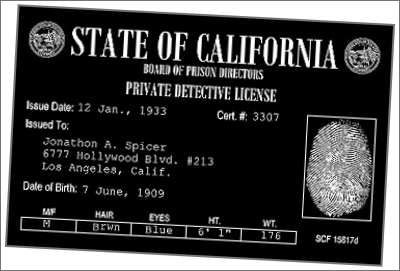 |
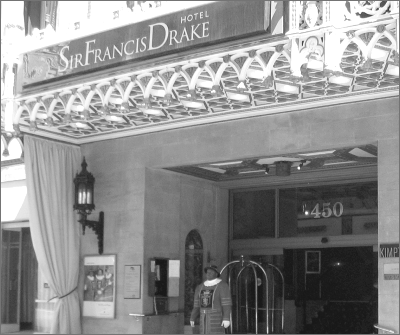 |
"Even though I've been to the 'City by the Bay' many times, the wacky layout of the streets still befuddles me. I sort of find my way around San Francisco by accident. Fortunately the Sir Francis Drake is right in the heart of town across from Union Square, making it pretty easy to find. I pulled to the curb at a loading zone next to the hotel's snazzy sidewalk marquee, and an equally snazzy doorman outfitted in a bright red conquistador costume quickly arrived to help me with my bags. Since I only had one suitcase, there wasn't much for him to do but hand my car key over to a valet parking attendant. For that he received a quarter tip." |
|
"When my chariot arrived, I slipped the attendant a quarter and nonchalantly made a circuit of the car to make sure the fenders were all still intact. My Chrysler Royal Business Coupe may be last year's model, but it's new to me, and because the automobile's gleaming paint and chromium plating represented what to me was a major investment, I was naturally concerned about its welfare." |
 |
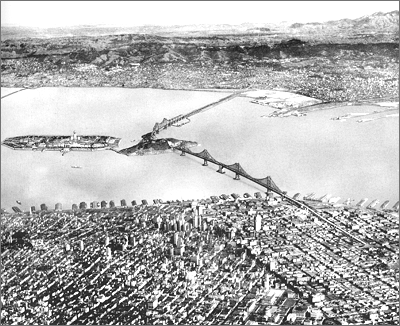 |
"The marvel of modern engineering over which my tires rolled was completed back in November of 1936. The press made a big deal out of the bridge's opening-even the Los Angeles press. That wasn't too surprising when you consider that the state's taxpayers paid seventy-seven million bucks to build the damned thing. Based on what little I recalled from the news stories, the bridge is something like eight miles long and consists of two sections. The part on which I was driving was a suspension bridge, which means the roadway dangles from gigantic cables slung between four enormous towers. The second half of the bridge, between Yerba Buena Island and Oakland, is supported by pilings driven deep into the bottom of San Francisco Bay. In order to keep automobile traffic from mixing with the trucks and streetcars, the bridge was built with two decks-the six-lane auto roadway I was on and a lower deck with both a roadway for trucks and rails for the trolley cars, if that's what they're called." |
|
"My first impression was one that included a hundred or so buildings of exotic architecture spread out across an absolutely flat island and interspersed with greenery, decorative ponds, and spire-like structures, all of which gave the place a mystical character like some mythical land from the Arabian Nights. Movement to my right caught my eye, and I turned to watch a huge, four-engine Pan American seaplane taxiing across the body of water separating Treasure Island from Yerba Buena Island. It was all quite impressive." |
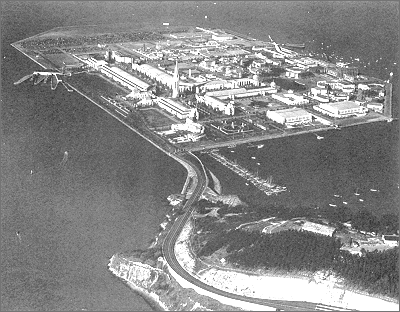 |
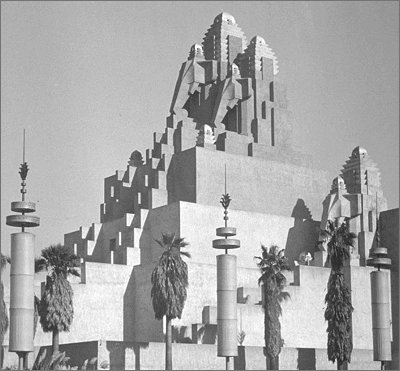 |
"This opening was flanked on either side by huge structures extending out toward the road. They looked like giant stacks of children's building blocks that became progressively smaller toward the top, creating pyramid-shaped towers. These towers appeared to be made of pink stone with stairways and impressionistic elephants decorating their fronts. All in all, they gave me the feeling I was looking at a Burmese or Siamese temple as interpreted by a cubist sculptor." |
|
"She stood at least eighty feet tall in front of a background decorated with silver stars. Sculpted from white stone, the woman wore a snazzy deco-style headdress and she was draped in a long gown, but the strangest part of her--besides the fact that she was just plain ugly--was her posture. Her arms were raised in exactly the same position assumed by a dog's front legs when it stands on its hind legs. For that reason I would have called her Dog Woman, but the name sculpted into her base was Pacifica. What this big, ugly dame had to do with the Pacific Ocean escaped me, other than the possibility that the bottom of that ocean might be a better place for her." |
 |
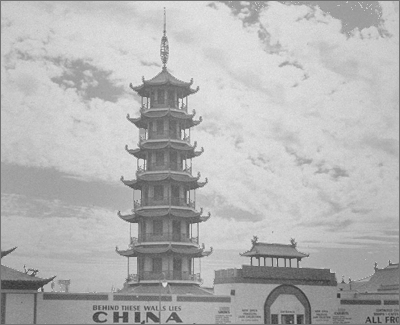 |
I was on a wide north-south walkway called Nanking Road. It was bordered on the east by a long, ten-foot-high wall bearing large signs in English and Chinese characters. The sign I could read said, 'Chinese Village.' The wall was interrupted by two entrances. I walked through the first I came to and found myself in a Chinese village or at least in what I imagined a Chinese village might look like. The rectangular space enclosed by the wall on all sides was large-easily the equal of two football fields in length and another two in width-and filled with an assortment of buildings that made me feel as if I'd stepped into a James Fitzpatrick travelogue on the mysterious Orient. |
|
"There it was--a huge silver flying boat with four powerful engines pulling it aloft. I asked Jeff if it was the famous Pan American Airways China Clipper I'd heard so much about. He said nonchalantly, 'Yeah, that's it. They take off around this hour two or three times a week, and everybody on the island stops to gawk.' Being one of the gawkers, I could certainly understand the attraction. It was a sight you didn't see every day-a mighty silver miracle of modern technology gracefully whisking its passengers off to adventures in exotic foreign lands. Then just before the Clipper disappeared into the fog, it began a gradual banking turn to the west. I imagined its passengers pressing their faces to the ship's windows for one last look at San Francisco. In a way I envied them. It must have been quite a view." |
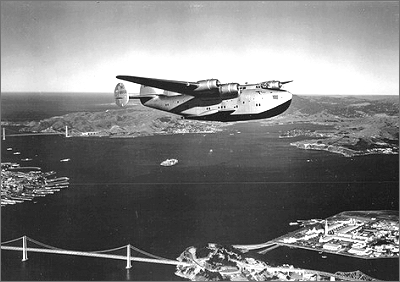 |
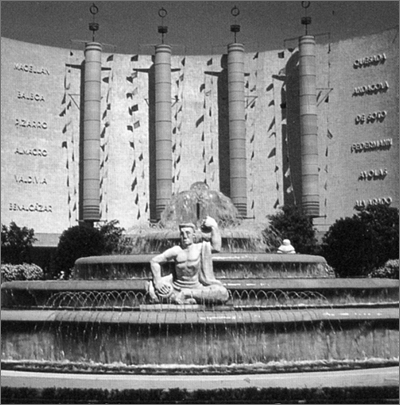 |
"Other features of the exposition also took on a new life in the sunshine. Ornate lampposts fitted with elaborate deco-style fixtures showed up, as did hundreds of colorful flags and banners fluttering in the breeze. Statuary, murals, and gracefully arched streams of water from decorative fountains appeared everywhere I looked. The buildings of the fair also came alive, their lavish facades, columns, and other gewgaws standing out in vivid relief, as did the vast differences in their architecture. Far from expert in such matters, I was confounded by the mishmash of cultural styles embellishing the exhibit halls, restaurants, and other structures. Some of the styles I thought I recognized were Mayan, Burmese, Malayan, Egyptian, and Gothic-all modern recreations of ancient designs. I estimated at least a hundred buildings were built for the exposition on Treasure Island, and no one of them seemed to share anything in common with any other." |
|
"Leaving the Chinese Village, Susie and Jeff turned right toward the parking lot, and I went the opposite direction to retrace the route I'd taken from the taxicab parking area that morning. I didn't make it very far, though, before I had to stop and stare in awe at the amazing spectacle the Golden Gate International Exposition became when the sun set. The walkways were brightly lit by the deco-moderne street lamps, but that was just the beginning. All of the many fountains were ablaze from spotlights that turned the spouting water into shimmering sprays of color. Every piece of statuary had its own illumination, and the exhibit halls glowed blue, green, and gold from even more concealed spotlights. I was surrounded by a scintillating rainbow that danced and sparkled with constantly changing hues."
|
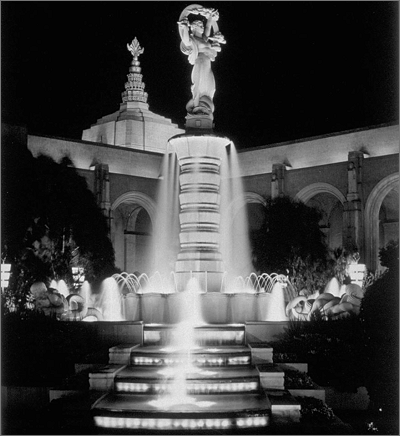 |
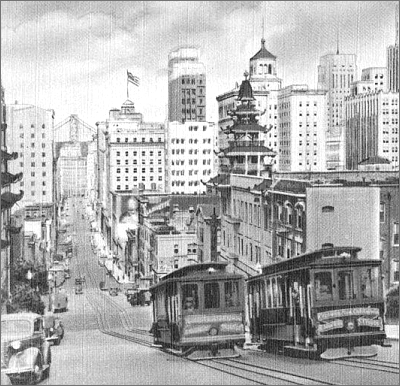 |
"Sometime back around the turn of the century, it was decided that the most efficient means of transporting the public up and down San Francisco's hills was a bus-like contraption that rides on rails and is powered by a moving cable under the street. The cable car's operator-called a gripman-uses a long lever extending through a slot between the rails to grab on to the moving cable, thus causing the car to move with it. When he wants to stop the car, he releases the cable grip and pulls on another lever that applies the car's barely adequate brakes. Now this method of conveyance seems practical until you find yourself driving behind one of these rolling antiques. The thing clanked, rattled, and shook so violently I wouldn't have been surprised to find myself dodging a trail of ancient parts behind it. Worse yet is the crucial moment between the time the brakes are released and the cable is gripped. When on an incline behind a cable car one can never be quite sure the damned thing won't roll backward down the hill, demolishing your car in the process." |
|
"Inside the Fairmont I found just about what I'd come to expect from high-class San Francisco hotels. An elaborately-paneled lobby ceiling was supported above a white marble floor by a plethora of Corinthian columns. A few thick area rugs and some rich wood wall paneling helped suck up some of the ambient noise echoing throughout the huge room like an ancient mausoleum. The overall feeling of the place was overstated elegance. The decor of the Fairmont's lobby was, however, slightly more tasteful than the gaudy red and gold trappings of the Drake. Neither was a place where I would choose to spend any more time than necessary." |
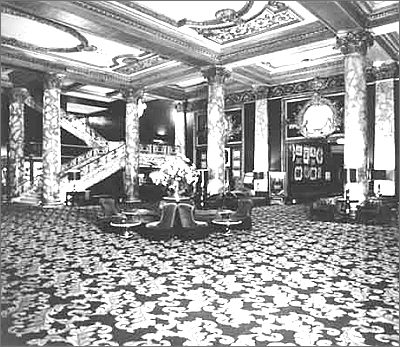 |
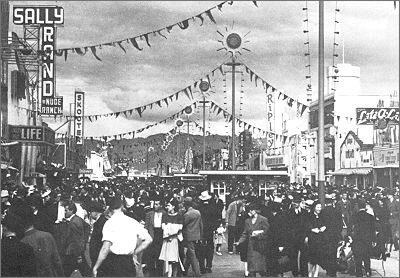 |
"The largest concentration of fairgoers was clustered in front of Sally Rand's Nude Ranch. That was no surprise. Beginning in the twenties, Sally earned her stripes--or more accurately, she'd taken them off--in burlesque houses from New York to San Francisco, acquiring the dubious title of the country's most famous stripper. Now it seemed Sally was moving up in the world, capitalizing on her name, and letting other women take off their clothes while she raked in the profits. According to my handy-dandy guide book, Sally's Nude Ranch was a show featuring women clad in little more than six-guns and cowboy hats performing ranch chores. Not exactly wholesome entertainment for the entire family." |
|
"In the afternoon sun, shadows were growing longer, emphasizing the height of the towers and elongating the shapes of the statuary. The sun also made all the fountains and waterways sparkle like fields of blue diamonds." |
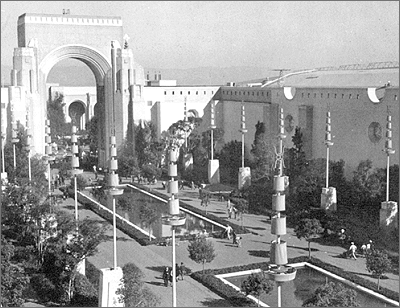 |
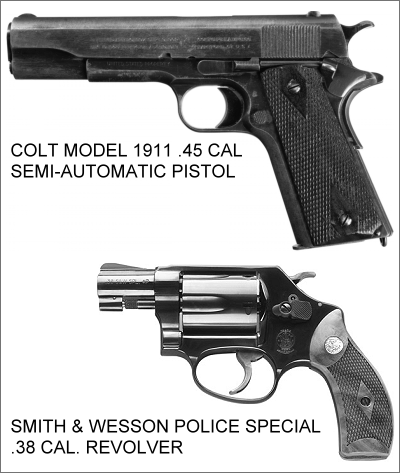 |
"I stepped out of my hiding place and started moving toward the goon, hoping he might surrender peacefully when he realized he was surrounded. He spotted me immediately, glanced back at Wilbur, and drew a pistol from inside his jacket. The goon was a fan of large artillery. The gun in his hand was a military-issue Colt forty-five semiautomatic. I responded by drawing my Smith & Wesson, and the goon did exactly what I would have done under similar circumstances. He chose the lesser of two evils, turning around and heading for the relative safety of the parking lot--a route that was blocked only by a security cop who had yet to draw his weapon." |
|
"Wailing sirens then heralded the approach of the ambulances Russo ordered, but Sergeant Bailey got there first. He arrived in an unmarked Chevrolet four-door sedan and pulled up at the parking lot end of Nanking Road. Four uniformed officers piled out of the Chevy with Bailey, who was in civilian clothes. Russo walked quickly toward the cops, and I followed along at a more leisurely pace. I was in no hurry for another dose of the sergeant's charming personality." |
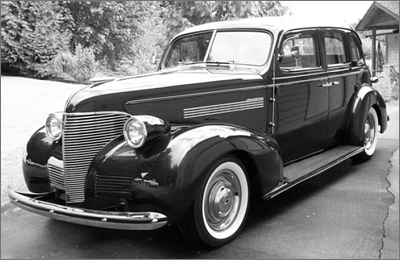 |
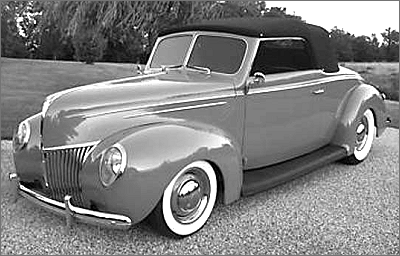 |
"When Susie came out, I escorted her out to Jeff's car, which definitely suited him. It was a spanking new Ford Deluxe--a flashy maroon convertible model. Watching Susie get in and adjust the seat so she could reach the pedals, I decided she was more of a Willys sort of gal-practical and efficient with no need of stylish gewgaws. I had to wonder how Susie and her brother turned out to be so different." |
|
"A sign informed me the tower was a monument to some rich old gal named Lillie Coit, who according to legend loved nothing more than watching firemen at work. According to another sign, the paltry sum of twenty-five cents would buy me a ride to the top of the tower via an elevator. I figured if I could pay some fellow a quarter for retrieving my car from the hotel parking garage, I could certainly afford another quarter for such a once-in-a-lifetime experience. From the circular observation floor, which yet another sign informed me was 180 feet above the top of Telegraph Hill, I could see San Francisco from ocean to bay. In spite of the fog, it was quite a view. I walked around the circumference of the tower looking out at misty views of such landmarks as the Golden Gate Bridge, Fisherman's Wharf, and to the east, the city's newest landmark, Treasure Island. Beyond Treasure Island I could make out the hills of Oakland, which appeared to be bathed in sunshine. Lucky Oakland." |
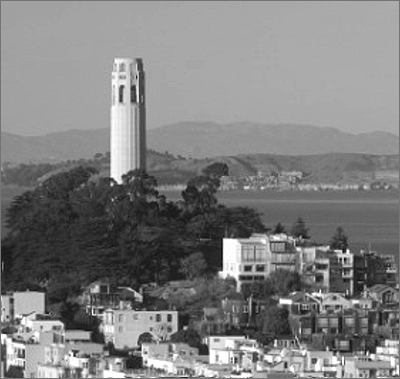 |
 |
"After starting the engine, I was getting myself comfortable for the drive ahead, when something that struck me as very strange caught my eye. My Chrysler was parked only a couple of spots from the parking lot perimeter road, and what I saw was a black four-door Ford sedan driving toward the parking lot exit. The strange part was the guy driving the Ford. It was Junior G-man, Tom Kendall. Now what the hell was he doing this far from home? Something told me the answer to that question might prove interesting, so I pulled out behind the Ford and followed it from the parking lot and toward the bridge." |
|
"Then I was in what passed for downtown Port Costa--two blocks containing a dozen or so wood-frame buildings and a three-story brick warehouse. Small though it was, the little burg boasted two hotels, a post office, some eateries, and at least two saloons, along with the typical purveyors of goods and services. The street ended at a Southern Pacific train yard and the rotting remains of some long docks poking out into the Carquinez Strait. I wondered what made Port Costa worthy of such attention from the mighty S.P., but my curiosity didn't last long. U-turning at the end of the main drag, I spotted Kendall's black Ford tucked out of sight in an alleyway between the railroad yard and a dilapidated hotel on the west side of the street opposite the brick warehouse."
|
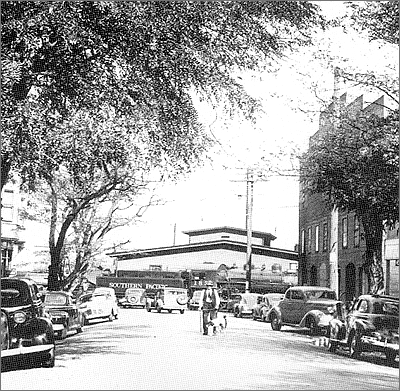 |
 |
"The farther I got up the stairs, the worse things got. The place stunk of mildew, stale tobacco, and other things I preferred not to think about; the hardwood floors were scuffed raw; and what was left of some pale green wallpaper was stained and peeling. The joint hardly seemed suitable for a visiting international dignitary . . . unless you wanted to stash one someplace well off the beaten path." |
|
"The magazine photo of Sun Ling I'd been carrying around for several days didn't begin to do her justice. The doll was absolutely breathtaking despite the fact she'd been holed up in a cheesy hotel for nearly a week. I said, 'It's good to finally meet you, Miss Sun.' Sun Ling smiled a little tentatively as if she wanted to be polite, but wasn't really sure that my arrival on the scene was anything to smile about. I could hardly blame her for that because I had some doubts of my own along the same lines."
|
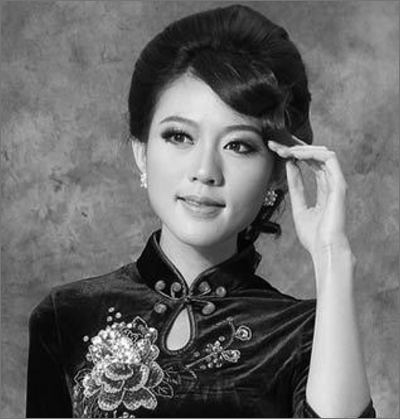 |
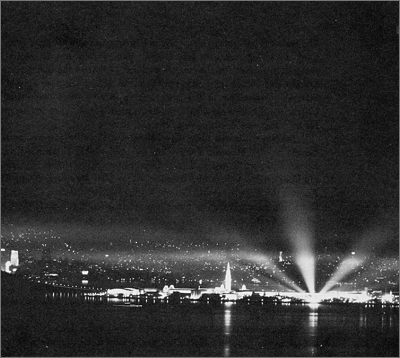 |
"Crossing the causeway to Treasure Island, I was treated to an impressive electrical display including both the multi-hued extravaganza of the exposition and the twinkling lights of San Francisco across the bay." |
|
"'Sergeant, something tells me you don't think very highly of this engineering marvel.' 'I don't. It's nothin' but a big eyesore. I liked it a whole lot better when we took ferries across to Marin. It was slower, but better--more natural like. And nobody ever tried to do themselves in by jumping off a freakin' ferryboat.' 'You get a lot of suicides here, do you?' 'Yeah. Eleven since the bridge opened. It's a big pain in the butt. The bridge people keep coming up with schemes to stop 'em, but the crazies always find a way. If it wasn't for all the extra work they make for us, I'd say let 'em jump. If they're nuts enough to think diving 200 feet from this bridge is a good way to end it all, we probably don't need 'em around anyway.' 'Your concern for your fellow man is touching.' 'Screw my fellow man!'"
|
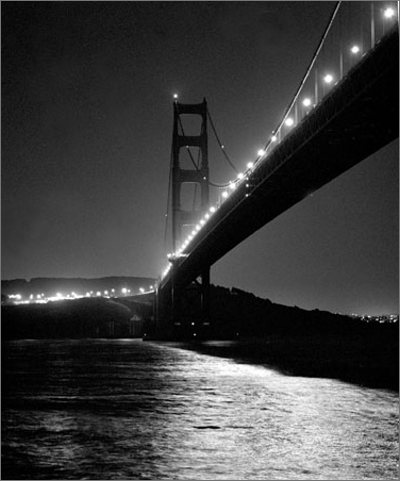 |
![]()